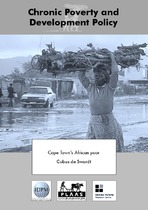| dc.description.abstract | The typical ‘face of poverty’ in South Africa is no longer that of a rural woman engaged in subsistence agricultural production. Poverty today also refers to the large number of unemployed men who wait daily in vain on street corners for a casual job, women suffering from among the highest rates of HIV/Aids infection in the world, large numbers of children living in areas with among the highest crime and murder rates in the world, and poor black communities which continue to be excluded from the economic riches of our country. We can no longer ignore the problem of urban poverty.
A large part of Cape Town’s less affluent population live on the Cape Flats, which was relatively unpopulated until the 1960s. Since then, two waves of settlement took place: the period after the 1960s saw the forceful resettlement of so-called ‘Coloured’ people through apartheid socio-spatial engineering, and in the 1980s a then illegal process of large-scale African migration from the impoverished areas of the Eastern Cape began (see Hindson 1987; Tomlinson & Addleson 1987).
Numerous studies (see Swilling et al. 1991, for example) demonstrate how the combined effects of social engineering, spatial planning and rural-urban migration have contributed to urban sprawl, the expansion of racialised economic geographies, and the creation of an apartheid city. At present, the townships of Khayelitsha and Greater Nyanga are home to three quarters of a million people. The uniqueness of Cape Town’s urban sprawl is not restricted to its recent and rapid population growth, but also lies in the fact that it reflects a nexus of extremes (DBSA 1998; O’Leary et al. 1998). Cape Town has a strong and relatively varied economy with a monocentric structure, characteristic of South African cities. In a typical centre-periphery fashion, it represents a polarised city centre where affluent suburbs and economic activity present a contrast to the overcrowded, impoverished township periphery (Myonjo & Theron 2003a; 2003b). Whereas the majority of white and wealthy black people live opulent lifestyles, the majority of those on the Cape Flats live in abject poverty. This paper seeks to gain a greater understanding of the socio-economic realities and livelihood challenges facing the residents of Khayelitsha and Greater Nyanga. | en_US |

